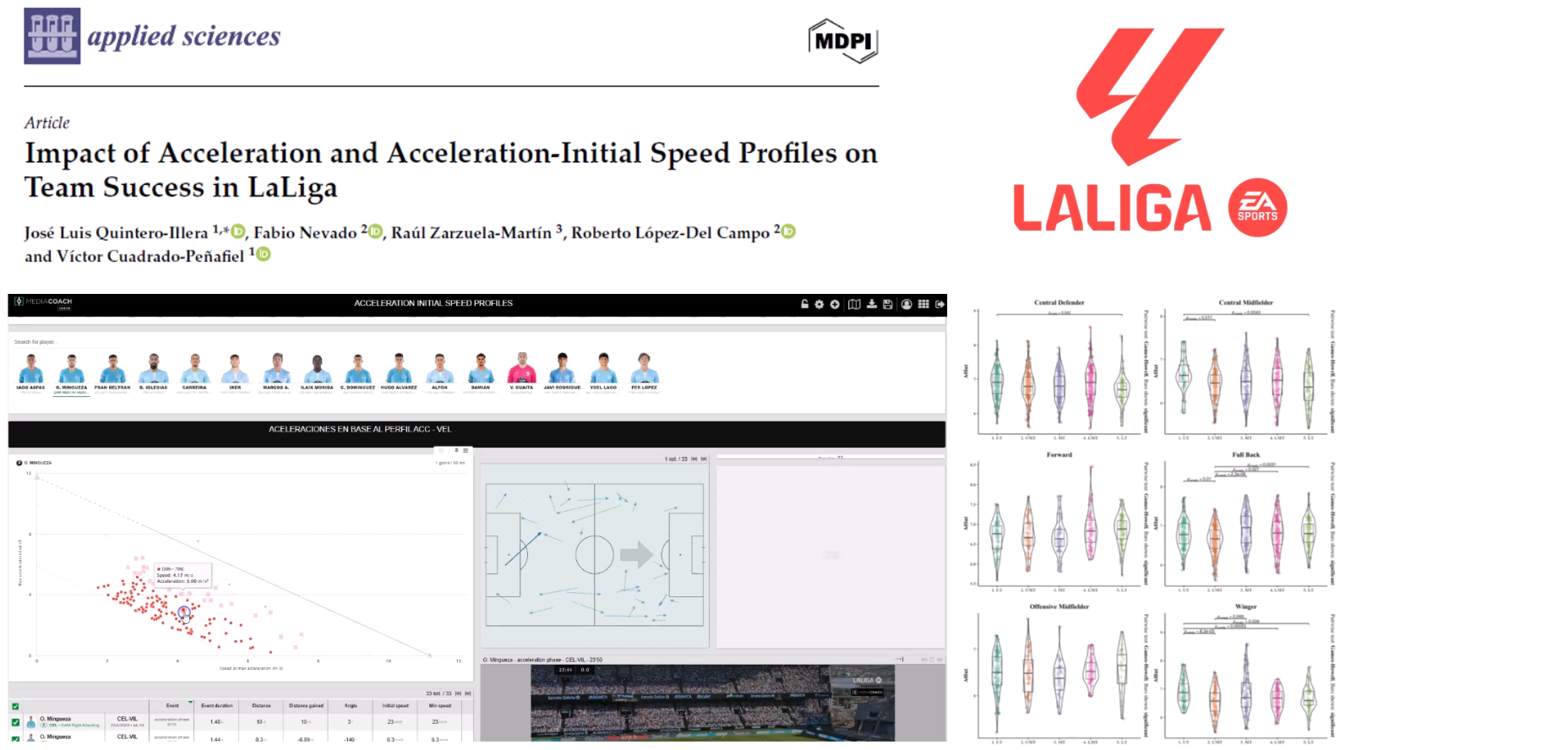
24 Abr High-Intensity Acceleration and Initial Speed Profiles as Predictors of Team Success in Professional Football: What We Know and How to Use It
1. Introduction: Why Acceleration Matters in Modern Football
In modern football, success is increasingly determined by the capacity to execute frequent, high-intensity actions—particularly accelerations and short-distance sprints—that often precede key events such as shots, recoveries or goal situations. While traditional metrics like total distance covered or maximum sprint speed have long dominated performance analysis, recent investigations suggest these may offer limited insight into actual match-winning dynamics.
Our most recent study, «Impact of Acceleration and Acceleration-Initial Speed Profiles on Team Success in LaLiga» (https://doi.org/10.3390/app15084344), provides evidence that players from top-ranked LaLiga teams (Top 4) not only accelerate more frequently at high intensity (>3 m/s²), but also show superior acceleration capabilities from various initial running speeds, particularly in key positions like central midfielders, full backs, and wingers.
This investigation builds on a growing body of work from LALIGA’s Football Intelligence & Performance area that has explored the multifactorial relationship between physical performance, contextual variables, and competitive outcomes.
2. Methods: A Robust Sample Across Two Competitive Seasons
- Sample: 309 male professional players (excluding goalkeepers) from LaLiga across the 2021/22 and 2022/23 seasons, totaling 6180 match observations.
- Technology: TRACAB Gen5 and Mediacoach® systems provided high-frequency (25 Hz) 3D tracking data.
- Metrics analyzed:
- A₀Int: Max theoretical acceleration from 0 speed.
- S₀Int: Max theoretical initial speed beyond which acceleration is no longer sustained.
- Accelerations >3 m/s² as a measure of high-intensity explosive efforts.
Players were classified by position and team ranking, creating five competitive tiers from Top 4 (UT) to Bottom 4 (LT).
3. Key Results and Practical Insights
3.1. More Accelerations, More Success
- Teams in the Top 4 performed significantly more accelerations >3 m/s² in positions such as:
- Central Midfielders: 88.78 vs. 79.58 (LT)
- Full Backs: 94.30 vs. 84.72 (LT)
- Wingers: 95.43 vs. 84.88 (LT)
→ Practical implication: Regular high-intensity accelerations differentiate the physical profile of top teams. This aligns with prior findings that match-deciding actions (e.g. goals, recoveries) often occur during or immediately after high-intensity transitions (https://doi.org/10.1080/24733938.2022.2100462).
3.2. Acceleration Capacity from Lower Speeds is a Differentiator
- Top-ranked players exhibited superior A₀Int values, especially in:
- CM: 6.66 m/s² (UT) vs. 6.37 m/s² (LT)
- Wingers: 6.91 m/s² (UT) vs. 6.66 m/s² (LT)
→ Practical implication: Training should target explosive accelerations not only from static positions, but also from jogging or moderate-speed movements, reflecting in-game demands.
4. Building on Prior Evidence: Integrating Past Studies
This new study provides granularity to what previous LALIGA research has already outlined:
- Total running distance alone is not predictive of success. Studies such as https://doi.org/10.12800/ccd.v18i57.2018 and https://doi.org/10.3390/ijerph17238815 have shown that higher-ranked teams sometimes run less overall, especially in high-speed zones without the ball.
- The role of ball possession and sprinting with the ball: Successful teams cover more distance at >14 and >24 km/h with possession (https://doi.org/10.5114/biolsport.2023.118021, https://doi.org/10.5114/biolsport.2024.133667).
- Sprint actions are key to goal creation. Over 45% of goals are preceded by sprints, especially from wide players (https://doi.org/10.1080/24733938.2022.2100462, https://doi.org/10.1080/24748668.2023.2262813).
- High acceleration loads increase injury risk, particularly for hamstring injuries (https://doi.org/10.5114/biolsport.2024.127387). This reinforces the need to monitor acceleration frequency and intensity closely.
5. Practical Applications for Coaches and Practitioners
| Application | Description |
|---|---|
| Training Design | Incorporate short, high-intensity acceleration drills from both static and dynamic starts. Emphasize context-specific movements (e.g., from pressing situations or after ball reception). |
| Individual Monitoring | Use AS0 profiles to detect drop-offs in explosive capacity over the season. Compare player metrics to Top 4 reference values (see infographic). |
| Position-Specific Planning | Midfielders and wide players need a higher acceleration profile. Forward players may not always show higher frequency but require optimized starting speed. |
| Injury Prevention | Use acceleration data to control cumulative mechanical load and anticipate overload risk, especially for hamstrings. |
6. Conclusions and Future Directions
This study confirms that frequent high-intensity accelerations and explosive capabilities from varying initial speeds are associated with success in professional football—particularly in certain positions. It suggests that physical preparation and load monitoring should move beyond traditional metrics and incorporate acceleration profiling (AS0) to guide training and performance management.
Future research should combine this approach with technical-tactical context (e.g., actions during possessions, transitions, or pressing phases), as suggested in works such as https://doi.org/10.3390/sym12061052 and https://doi.org/10.5114/biolsport.2022.105331.
? Suggested Readings and Related Studies
- https://doi.org/10.3390/app15084344 — Acceleration and Team Success (2025)
- https://doi.org/10.5114/biolsport.2023.118021 — Match Running + Technical-Tactical Performance
- https://doi.org/10.12800/ccd.v18i57.2018 — Physical Performance and League Rankings
- https://doi.org/10.3390/ijerph17238815 — Sprint Capacity and Team Ranking
- https://doi.org/10.5114/biolsport.2024.127387 — Injury and Acceleration Demand


